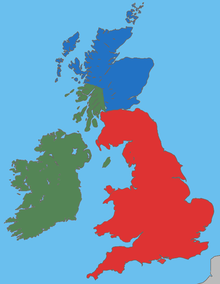Insular Celts
By the 10th century, the Insular Celts had diversified into the Brittonic-speaking Welsh (in Wales), Cornish (in Cornwall), Bretons (in Brittany) and Cumbrians (in the Old North); and the Goidelic-speaking Irish (in Ireland), Scots (in Scotland) and Manx (on the Isle of Man).
In the 1970s, a "continuity model" was popularized by Colin Burgess in his book The Age of Stonehenge, which theorised that Celtic culture in Great Britain "emerged" rather than resulted from invasion, and that the Celts were not invading aliens, but the descendants of, or culturally influenced by, figures such as the Amesbury Archer, whose burial included clear continental connections.
In an alternative scenario, the migration could have brought early Celts first to Britain (where a largely undifferentiated Insular Celtic was spoken initially), from whence Ireland was colonised only later.
Schrijver has pointed out that according to the absolute chronology of sound changes found in Kenneth Jackson's "Language and History in Early Britain", British and Goidelic were still essentially identical as late as the mid-1st century CE apart from the P/Q isogloss, and that there is no archaeological evidence pointing to Celtic presence in Ireland prior to about 100 BCE.
Common Brythonic, on the other hand, split into two branches, British and Pritenic as a consequence of the Roman invasion of Britain in the 1st century.
Migration has been shown to play a key role in the spread of the Bell Beaker culture to the British Isles around 2500 BC.
The introduction to the British Isles of Bell Beaker culture came with incoming high levels of steppe-related ancestry, about 90% of the gene pool being replaced within a few hundred years.[4][relevant?]
[5] This similarity supported earlier findings in suggesting a large pre-Celtic genetic ancestry, likely going back to the original settlement of the Upper Paleolithic (later debunked).
[citation needed] In 2006, two popular books, The Blood of the Isles by Bryan Sykes and The Origins of the British: a Genetic Detective Story by Stephen Oppenheimer, discuss genetic evidence for the prehistoric settlement of the British Isles, concluding that while there is evidence for a series of migrations from the Iberian Peninsula during the Mesolithic and, to a lesser extent, the Neolithic eras,[citation needed] there is comparatively little trace of any Iron Age migration.
Later genetic studies found evidence for some Late Iron Age migration of Celtic (La Tène) people to Britain and on to north-east Ireland.
The earliest tribal names on record date to the 1st century CE (Ptolemy, Caesar; to some extent[clarification needed] coinage), representing the situation at the moment of Roman conquest.
The "protohistoric" period of Ireland can be argued to begin around 400 CE, due to cultural diffusion from Roman Britain, importing writing (ogham, reflecting the earliest records of Primitive Irish) and Christianity.
With the Anglo-Saxon invasion and settlement of Great Britain in the 5th and 6th centuries, the British languages were gradually marginalised to the western parts of the island, to what is now Wales and Cornwall.
The transition may not necessarily present itself as a mass immigration with a substantial replacement of population, but rather could involve the arrival of a new elite installing their culture and language as a superstrate.



